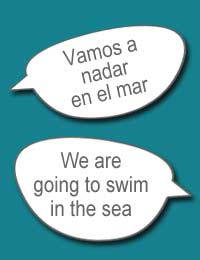How to Learn Future Tense in Spanish

Spanish is a very fluid language, and has more than one way of expressing the future. In fact, sometimes the present and future tenses can seem almost interchangeable.
Essentially, there are two main ways of expressing the future in Spanish, known as the ‘future immediate’ and the ‘future simple.’
The Future Immediate
This describes an action which is about to happen. It is the same in English as saying you are ‘going to do’ something. You form it by using the appropriate form of ir, the irregular verb ‘to go’, followed by ‘a’, followed by the infinitive of the verb you want to use. There is a very similar structure in English. So:Vamos a nadar en el mar.
We are going to swim in the sea.
El jefe va a volver a la oficina la semana que Vicente.
The boss is going to come back to the office next week.
Here is the present tense of the verb ir, which you will need to make this construction:
- Voy
- vas
- va
- Vamos
- vas
- van
The Future Simple
This may not be the only, or even necessarily the most common, way of expressing the future, but it’s worth making the effort to get your head around this tense anyway.The future simple is formed by adding the right endings to the stem – which in this case of this tense is the whole of the infinitive. While the endings are the same for all verbs, sometimes the stem, which always ends in ‘r’, is irregular. These are given below.
Note the stress accent, which falls on all the endings apart from the ending ‘emos’.
The endings are as follows:
For a verb like comprar, to buy, which ends in –ar:
- Compraré
- Comprarás
- Comprará
- Compraremos
- Comparéis
- Comprarán
For a verb like comer, to eat, which ends in –er:
- Comeré
- Comerás
- Comerá
- Comeremos
- Comparéis
- Cimmerán
For a verb like vivir, to live, which ends in –ir:
- Viviré
- Vivírás
- Vivírá
- Viviremos
- Viviréis
- Vivirán
Irregular Stems
Note that the following verbs all have irregular stems for making the future. No special magic, unfortunately, they just have to be learned. Setting aside a few minutes a day to learn one or two verbs will soon help a learner increase their knowledge.The first person (Yo/I) is detailed below. Remember that the endings remain unchanged:
- Caber (to fit e.g. people in a car) cabré
- Decir (to say) diré
- Haber (to have) habré
- Hacer (to do, make) haré
- Poder (to be able to) podré
- Poner (to put) pondré
- Querer (to want, love) quereré
- Saber (to know) sabér
- Tener (to have) tendré
- Venir (to come) vendré
- Valer (to be worth) Valdré
Tip for Using the Future Simple
The stem of many Spanish verbs stays the same regardless of the tense that is used. It is important, therefore, to use the verb ending to indicate the tense. One tip for learners of Spanish when they use the future simple tense is to really emphasize the accented syllable. As a learner becomes more fluent then this this will come second nature, however for a beginner it may seem a little strange. It is this emphasis on the final syllable, however, that helps to make the tense that is used clear.- Spanish Words to Watch Out For
- The Subjunctive in Spanish
- Irregular Verbs in Spanish
- The Past Imperfect Tense in Spanish
- The Conditional Tense in Spanish
- The Past Preterite Tense in Spanish
- Personal Pronouns in Spanish
- The Infinitive in Spanish
- Ser and Estar in Spanish
- The Present Tense in Spanish
- Por and para in Spanish
- Accents in Spanish
- Personal a in Spanish
- Adjectives in Spanish
- Gender of Nouns in Spanish


Re: Spanish Phrases for Hotels
Hi, I work in a hotel in the US. I'm trying to learn phrases in Spanish to speak to my Spanish speaking guests. Phrases…
Re: Spanish Numbers Days and Months
How do you say the twelfth month in Spanish. Not the month itself. Just that phrase
Re: Personal Pronouns in Spanish
How come vosotros isn't in the subject pronouns?
Re: The Influence of Spanish on English
I have found this website very useful and the present article has helped me a lot in understanding the influence of…
Re: The Past Preterite Tense in Spanish
magb123 - Your Question:You have a typo on 'ser'. The first person singular is 'fui' not 'fu'Our Respo
Re: The Past Preterite Tense in Spanish
you have a typo on 'ser'. The first person singular is 'fui' not 'fu'
Re: Spanish Numbers Days and Months
I´m spanish, i could give custom classes to anyone interested.
Re: The Past Preterite Tense in Spanish
Some typos on this otherwise excellent page: "Ponder" for poder and "fu" for fui. You need a proofreader.
Re: Colours in Spanish and How They Are Used
i really found this site very helpful as a college student! thanks